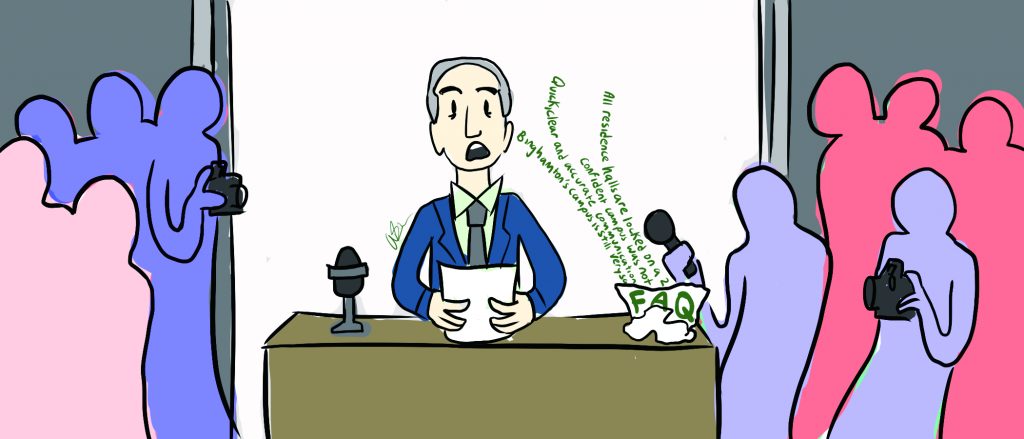Binghamton University has responded to the fatal attack in Mountainview College on April 15 in various ways — last Thursday, the administration released a list of frequently asked questions related to the event, and University President Harvey Stenger spoke at the Student Association Congress meeting on Monday evening to address campus safety concerns, prompting the Editorial Board to examine these responses and give criticism and credit where it is due.
The University’s list of frequently asked questions was largely misleading and led to many more questions than it answered. The first three questions the University addressed were the only ones that seemed specific to this incident, while the others seemed cookie-cutter; as if they could have been written in response to any emergency.
One of our main concerns is that the FAQ denies there was a manhunt on campus. The FAQ states, “There was never a manhunt on campus, though many areas of the campus were searched for evidence as part of the investigation.” While we don’t know the specifics of the investigation, the Editorial Board has trouble believing this to be true given the available details. We understand the limitations of how much information authorities can release during an ongoing investigation, but regardless of whether the increased police presence on campus was solely to search for evidence, this answer seems to be misleading because Michael Roque was arrested in Hunter Hall of Mountainview College, meaning there must have been some kind of search conducted on campus. Something doesn’t add up, and students deserve the rest of the equation sooner rather than later.
Additionally, in the original version of the FAQ released on April 19, the University stated, in response to the question “What safety measures are in place in residence halls?,” that there are security access telephones located outside of each residence hall at its main entrance. The answer also stated there is a campus watch program in place similar to “neighborhood watch” programs, and explained that resident assistants are trained in conflict resolution and emergency response. The University then listed six on-campus organizations with which Residential Life works closely, including Harpur’s Ferry student ambulance and the University Counseling Center.
However, the FAQ has since been altered, and as of April 25, it only states that “All residence hall doors are locked on a 24-hour basis, requiring key-card access.” We question why the University changed this response in the FAQ from the original version, which listed four bullet points, and now only lists one. We also wonder whether or not these changes were made after we contacted Ryan Yarosh, BU’s director of media and public relations, with questions regarding the FAQ. In our last editorial, we called for increased and clearer communication from the University, and with that, we argue that students deserve more transparency — particularly in cases like this. Even though the FAQ was altered and, at times, misleading, it does address the University’s need to reconsider its current safety measures on campus.
The fourth question of the FAQ discusses the efforts that the University will take to improve campus safety moving forward. Although the Editorial Board believes there still remain unanswered questions regarding the situation, both as a whole and as a result of the FAQ, we recognize President Stenger’s remarks at the recent SA Congress meeting, where he addressed crucial security concerns. At the meeting, Stenger announced plans to transition to a new campus emergency alert system in which there is one button in the dispatch office that can send a campuswide alert immediately, rather than requiring the multiple steps the current process requires. This system is also used by Florida State University and Ohio State University, so we appreciate that the administration has looked into methods used by other universities in order to bring us up to par with our counterparts.
Stenger explained at the meeting that with the new system, the information sent out to students would not always be specific at first; it would simply tell students that an incident has occurred and urge students to stay safe. The University stated in the second question of the FAQ that the initial B-Alert on April 15 was not sent out until 45 minutes after the attack because police were ensuring their information was correct. However, we believe that it is in students’ best interest to be alerted of a dangerous situation immediately, and to receive more details later, rather than to wait for a more specific message that might only reach us after we are at risk. Thus, we commend the University not only for quickly following through with its promise to listen to students and improve upon the current emergency alert procedures, but also for realizing that student safety is paramount and a rapid response is key.
Per the Clery Act, a federal law that mandates that universities must disclose campus security information, BU is legally required to alert students of a dangerous situation. However, the Clery Act does not outline a specific time frame in which it must alert us, leaving it to the discretion of administrators to set up and publicize a procedure for doing so. We appreciate that the University is planning to implement this new system that will alert us immediately, going beyond what federal law requires to keep us safe.
We understand that there are no easy solutions to improving campus safety after the tragedies that have occurred over the past several weeks. While we are pleased to see that the University is, for the most part, taking steps to strengthen its safety protocol, we still hope that the administration will further examine how it communicates with students during emergencies. In the coming months, we expect to see more progress and to receive more clarity on a situation that seems to be clouded at this time.



